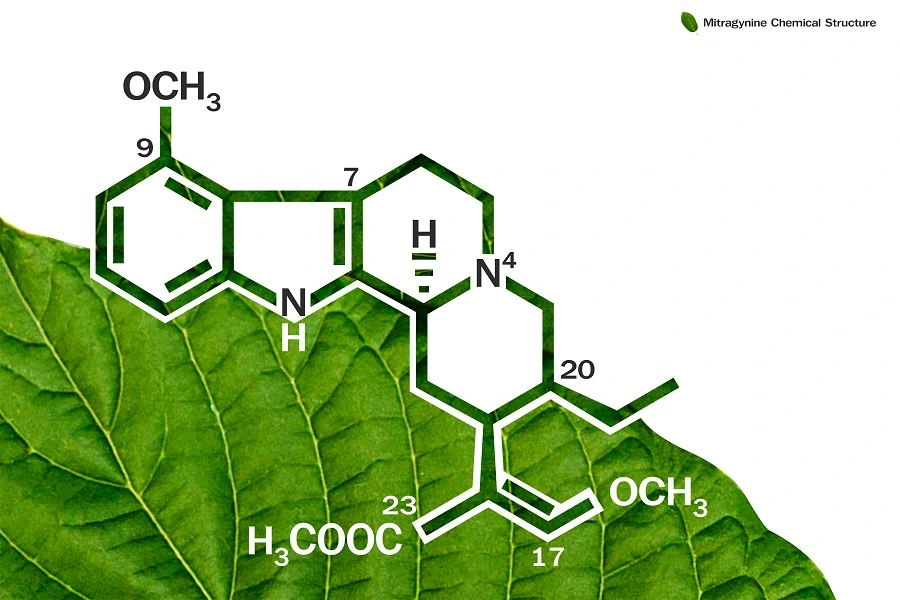What is Kratom? Is It Addictive?
This entry was posted in Addiction News, Drug Abuse and tagged kratom addiction, kratom treatment, what is kratom on September 26, 2022 by Justin Baksh, MS, LMHC, MCAP, Chief Clinical Officer.

Kratom is sold legally in all but six states and select counties across the nation. It can be found in vitamin stores, smoke shops, a smattering of bars, and gas stations. Thousands of users swear by it to boost their mood and energy levels or to relieve pain.
Here’s the concern: On a quest to soothe opioid withdrawal and cravings, some are flocking to kratom — and are surprised to find themselves dependent on it. Worse, some are relapsing back to their original, stronger, and cheaper drug of choice as their cravings are stoked.
There is a good reason for this: Kratom acts on opioid receptors just as opioid drugs do. While not everyone who ingests kratom (or opioids, for that matter), becomes addicted, some do. Especially for those already prone to addiction, Kratom may not be the harmless, “natural” option to opioids it may be believed to be.
“’It’s preying on the weak and the broken,’” said Ms. Pankova, 23, a Brooklyn native who received treatment in Delray Beach. “’It’s a mind-altering substance, so people like me who are addicts and alcoholics, they think just because it’s legal, it’s fine. It’s a huge epidemic down here, and it’s causing a lot of relapses.’”
(Schwarz, 2016)
What is Kratom?

The tropical region of southeast Asia is the home of the kratom tree (Mitragyna speciosa). Indigenous to Thailand, Indonesia, Malaysia, Myanmar, and Papua New Guinea, this evergreen tree is a part of the coffee family. Kratom tree leaves have been foraged and used as herbal medicines by natives of the land for centuries.
The tropical region of southeast Asia is the home of the kratom tree (Mitragyna Speciosa). Indigenous to Thailand, Indonesia, Malaysia, Myanmar, and Papua New Guinea, this evergreen tree is a part of the coffee family. Kratom tree leaves have been foraged and used as herbal medicines by natives of the land for centuries.
How is Kratom Used?
To experience the effects of Kratom, leaves are chewed, brewed in teas, and at times mixed with cough syrups, codeine, and even soda. Kratom leaves can also be dried and crushed into powders, which are then encapsulated, made into extracts, or smoked. Like many other substances, Kratom can be manipulated into various forms to be administered. Kratom herbal preparations sold on the market can be “pure” or mixed with other substances.
What is in Kratom?
The kratom plant’s chemical structure contains alkaloids, glycosides, polyphenols, terpenoid saponins, and flavonoids. The plant is particularly rich in alkaloids, counting over 40. Two of those alkaloids are mainly responsible for kratom’s effects.
The kratom plant’s chemical structure contains alkaloids, glycosides, polyphenols, terpenoid saponins, and flavonoids. The plant is particularly rich in alkaloids, counting over 40. Two of those alkaloids are mainly responsible for kratom’s effects.
- Mitragynine is a mu, kappa, and delta opioid receptor agonist with a potency that has been compared to codeine. It has been shown to block pain and act on dopamine and serotonin receptors, among other effects. Mitragynine is what gives users the pleasurable feelings of optimism, motivation, and increased energy when ingesting kratom. The concentration of mitragynine in Kratom products is approximately 2%.
- 7-hydroxymitragynine (7-OH-mitragynine) is a mu-receptor agonist that is 10 to 20 times more potent than morphine and binds at a 22.5 times higher rate. 7-OH-mitragynine is found in a much smaller concentration than mitragynine, accounting for approximately two percent of kratom’s chemical makeup. Some research has shown that, once processed in the liver, higher levels of 7-OH-mitragynine are produced in the body. 7-OH-mitragynine is found in a much smaller concentration than mitragynine, accounting for approximately 0.01% to 0.02% (in some cases, 7-OH-mitragynine is absent). (Kruegel et al., 2019).
Effects of Kratom Use
Dosage determines Kratom’s effects on the body and mind. A low dose of kratom (one to five grams) may produce stimulatory outcomes, while a higher dose (five grams or greater) may produce opioid-like pain-killing and sedative effects.
It takes just five to 10 minutes for kratom to produce an effect. However, the duration of this effect, which is typically two to five hours, can vary based on the dosage as well. The half-life of kratom is approximately three hours. This can increase in people who take kratom regularly.
Perceived Benefits of Using Kratom
- Altered State of Consciousness (high)
- Decreased Anxiety
- Improved Mood
- Increased Energy and Alertness
- Increased Ability to Focus and Concentrate
- Relaxation and Sedation
- Talkativeness
Kratom Adverse Effects
- Aggression
- Anorexia
- Constipation
- Death
- Dizziness
- Drowsiness and Fatigue
- Excessive Sweating
- Hallucinations
- Hepatotoxicity
- Increased Urination
- Insomnia
- Itching and Sweating
- Liver Damage
- Loss of Appetite
- Nausea and Vomiting
- Psychosis
- Seizures
- Tachycardia
- Tremors
- Weight Loss
Combining Kratom with other drugs can increase these effects. Kratom is often used with alcohol, benzodiazepines, opioids, cocaine, or amphetamines, which can be very dangerous and lead to other health complications as well as dependency.
Kratom Withdrawal Symptoms
Cessation of kratom can bring on withdrawal symptoms, including:
- Anxiety
- Cravings
- Diarrhea
- Depression
- Fatigue
- Hot Flashes
- Insomnia
- Muscle Aches and
- Cramping
- Nausea
- Runny Nose
- Sweating and Tremors
- Vomiting
- Watering Eyes
Kratom’s Use in the US
There are an estimated 10 to 15 million kratom users in the United States according to data on kratom import and sales.(Singh et al., 2020).
Kratom User Profile
An anonymous survey of 8,049 respondents who are kratom users yielded the following results:
- 89.4% Non-Hispanic White
- 56.8% Employed
- 50% Male/50% Female
- 63.2% Income over $35,000
- 82.3% with Some College Education
- 34.75% are 31 to 40 Years Old
- 25.3% are 21 to 30 Years Old
- 20.5% are 41 to 50 Years Old
- 21% are 51 to 60 Years Old
- 4.9% are 61 and Older
The most common reason cited for using kratom was to relieve pain, with 68 percent of users citing this reason, closely followed by mental conditions/emotions at 66 percent.
The vast majority are taking it orally, in a liquid or capsule form. The most common dosing was:
- 40% used 1 to 3 grams per dose
- 32% used 3 to 5 grams per dose
The most common use patterns reported were:
- 34% used 1 to 7 per week
- 28% used 7 to 14
- 24% used 15 to 21
- 6% used more than 28 doses per week
(Grundmann, 2017) (Neitze, 2021)
Can You Overdose on Kratom?
“As a parent of a recovering addict, you’re always worried about getting that call. Because even in recovery you know there’s a chance for relapse. You build up a set of expectations that this could happen. But kratom was never what I thought would be the problem… It’s absolutely critical that kratom be regulated somehow, or barring that, information about it is disseminated, that people know the risks and that there be some guidelines on how much you can take and with what – rather than this totally unregulated, undirected environment where people quite innocently can kill themselves.”
– Larry Schwartz, father of Daniel Schwartz, a 29-year-old killed by a kratom overdose, with 4,058 ng/ml in his blood, according to the coroner’s report (Haarer, 2018).

There have been numerous fatal overdoses where kratom was determined to be the sole factor according to a coroner’s ruling on an autopsy report. News reports include the cases of:
- Jon Grove, 34, who collapsed on his co-worker’s bathroom floor from kratom overdose as indicated on autopsy report, on November 19, 2016. (Diez, 2017).
- Stephen Hamilton, a 38-year-old with diabetes, who died due to kratom overdose, with 2,500 nanograms per milliliter (ng/mL) in his blood, on March 25, 2017. (Ericson, 2022).
- Christopher Waldron, 27, who died with a mitragynine (the main active ingredient in kratom) blood level of 1.8 mg/L according to the autopsy, on July 7, 2017. (Paluska, 2017).
- Matt Dana, 27, a police sergeant and bodybuilder who died suddenly at home with his girlfriend from a pulmonary edema brought on by a kratom overdose in August 2017, as reported by the Associated Press. (Cerbone, 2017) (Ericson, 2022) (Jussim, 2017).
- Alexandr Gorelik, 35, who died when kratom reacted to his prescription Xanax, on January 30, 2018. (Ericson, 2022).
- Caleb Sturgis, a 25-year-old, with a blood kratom level of 2,700 ng/mL, whose cause of death was ruled to be acute mitragynine intoxication after he drank kratom tea on June 27, 2018. (Leigh, 2019)
- Daniel Schwartz, 29, died from acute mitragynine toxicity, according to the coroner’s report, when he went in for a nap and was later (Smith, 2022).
- Richie Nelson, 25, died suddenly from kratom overdose, as confirmed by a toxicology report, in February 2019. (Waugh et al., 2019).
- Patrick Coyne, 39, who died of a kratom overdose with a blood level of 770 ng/mL, on July 9, 2019. (Ericson, 2022).
- Jake Helmbrecht, 27, who died due to mitragynine toxicity with 3,500 ng/mL of mitragynine in his blood, according to the pathology report, in July 2020. He had been successfully treated for alcoholism in the past and turned to kratom to ease anxiety. (Kennecke, 2020).
- James Reilly, 21, found dead from a kratom overdose with “his face caked in vomit,” on February 5, 2021.(Ericson, 2022).
- Daniel Vidrine, 26, veteran of the Air Force, died of acute mitragynine toxicity in February 2021. (Jones, 2022).
In addition to scattered news reports above, there is no doubt many more overdose instances where kratom was in the system and/or partially responsible. Kratom users, current and potential, need to be aware of these dangers. The alarm has been sounded a few times over the years.
Other Reports of Kratom Overdoses
In 2019, the CDC reported nearly 100 deaths involving kratom during an 18-month period stretching from July 2016 through December 2017. seven Americans died solely from kratom overdose, while kratom was a contributing factor in an additional 84 in 27 states, according to a database of federal drug overdoses and reported by the Centers for Disease Control and Prevention (CDC). An additional 61 fatal overdoses had kratom in their system, although other drugs were found responsible for their deaths. These make up about one percent of the 27,000 overdose deaths studied. However, with overdoses, even one is too many. (Mundell, 2019)
A few other studies point to the fact that kratom overdoses may be underreported:
- In 2018, Colorado’s 9news identified six overdoses due solely to kratom in its review of three years of autopsy reports from the state’s 10 largest counties in terms of population. In these cases, it was the only drug in the deceased’s systems. Kratom was a contributing factor 17 times and it was found in the system (but not contributing to death) 27 times. (Haarer, 2018).
- More recently, Courthouse News found eight overdoses where kratom was solely to blame during a 10-month investigation. Six of these resulted in lawsuits against the sellers. They also reported the FDA had a total of 423 deaths related to kratom logged in its Adverse Event Reporting System in January 10 of this year. (Ericson, 2022).
Increasing Poison Control Center Calls
It has also been reported that U.S. Poison Control Center calls about kratom have increased over the years, from 13 in 2011 to 682 in 2017 to 1,087 in 2019. Dietary supplements/herbals/homeopathic the top 4 substance category prompting calls to the Center. (Bracho-Sanchez, 2019).

Also, a 2017 Clinical Toxicology study of over 1,800 poison control center calls spanning 2011 through 2017 found that:
- 52% of calls had serious outcomes, and
- 32% of calls ended with a medical facility admission
Those who took kratom with other substances insurance their chance of being admitted by over double in terms of having a serious medical outcome and nearly threefold for admission to a medical facility, (Nationwide Children’s Hospital, 2019).
Arguably, the rate of kratom overdose is a small fraction of those due to opioids, which numbered 80,816 in 2021. However, that doesn’t mean the risk is non-existent, especially when kratom is mixed with other drugs. Because of this, concerns over kratom, its effects, potential for addiction and overdose continue.
Is Kratom Addictive?
“I would try to dose in the morning when I would be doing work. I would actually feel that it was helping me get work done, even though it really wasn’t. Instead, it was distracting me and causing me to play video games. Now, after it’s wearing off, right after the work day’s over, I was just super irritability…. I must have been an absolute nightmare to be around… grumpy, low, all of a sudden, your energy just gets sucked out of you and all you can think about is your next dose. It is the most miserable form of existence that I’ve ever endured, because things that should make you happy – like being there for your family, activities with them, all of this stuff that should biologically should sprout enormous amounts of joy – comes second to your f—ing addiction, and that’s just the way it is.”
(Anonymous, 2022)
Individuals who engage with kratom use on a regular basis are at risk for chemical dependency. Those who continue to use kratom on a frequent basis are more susceptible to experiencing withdrawal symptoms. There is a risk for tolerance and cravings, as well as an increased risk for cross-tolerance with morphine.
Increased use of kratom may also result in Kratom Use Disorder (KUD). According to the Naturopathic Physicians Medical Board, “the risk of dependence development appears to be higher if the extract is used for harm reduction to mitigate opioid and illicit drug withdrawal or for self-treatment of pain.” (Naturopathic Physicians Medical Board).
The NPMB also reports that, in a case study of pregnant woman using kratom, children were born presenting with neonatal abstinence syndrome (NAS) as they were going through withdrawal.
There has been no shortage of anecdotal reports of a kratom addiction. Media reports include:
- Twenty-three-year-old Dariya Pankova, who found herself drinking increasing amounts of kratom until she relapsed with heroin. (Schwarz, 2016).
- South Florida resident Robert Waina, who found himself drinking “bottle after bottle,” trying to cut back and being unable to, and in withdrawal. He ended up in rehab – for a total of three times – to kick the addiction. (Schwarz, 2016).
- A 37-year-old schoolteacher with no substance abuse treatment history developed a kratom addiction, was unable to decrease her usage, and experienced severe withdrawal symptoms similar to opioid withdrawal. (Galbis-Reig, 2016).
- James, a 21-year-old who started using kratom after quitting drinking, found himself ingesting “heaps” of kratom leaves, suffered two bouts of seizures requiring hospitalization, and ended up being hospitalized two times and fatally overdosed in 2019, as mentioned above. (Ericson, 2022).
But what does the science say?
In a 2014 Drug and Alcohol Dependence cross-sectional survey of regular kratom users in Malaysia, every single respondent reported dependence. The survey included 293 young men who reported regular kratom use.
In the survey, using higher amounts of kratom as well as more frequent use was found to increase the risk of dependence, cravings and withdrawal in long-term users. The higher the daily dose, the more severe the dependence.
Animal studies did show that mitragynine didn’t foster dependence; however, 7-hydroxymitrgynine did. Both are active ingredients in kratom.

What is the Legal Status of Kratom?
Kratom is not regulated on a federal level in United States. It is legally sold in 44 states and in most counties as well. Nevertheless, the Drug Enforcement Agency (DEA) has listed kratom as a drug of chemical concern and the Food and Drug Administration (FDA) has not approved kratom for medical use.
There are varying state and county regulations and prohibitions against the use and possession of Kratom. It is illegal in Alabama, Arkansas, Indiana, Rhode Island, Vermont and Wisconsin. Some counties, such as Sarasota county in Florida, have banned it as well.
Attempt to Place Kratom on Schedule 1 List of Controlled Substances
The DEA announced its plan to classify the psychoactive components of kratom as Schedule I drugs, according to provisions of the Controlled Substances Act, in August 2016.
A public outcry promptly ensued: The DEA was flooded with 6,000 letters, a White House petition amassed 145,000-plus signatures, and a lawsuit was filed by kratom vendors. Sixty-two members of Congress also petitioned the DEA to allow for a comment period on the ban, in which over 22,000 submitted positive comments about kratom. The end result was that kratom was not placed on Schedule 1 list.
Currently, Kratom falls under the dietary supplement category with the Food and Drug Administration, although that may change. In fact, kratom has been labeled as a “drug of concern,” with alkaloids that are psychoactive and deemed to have no medical benefit.
Legal Status of Kratom, by Country
While kratom has been in the United States since about the 1980s, it has been in its countries of origin for significantly longer than that. One clue about Kratom’s potential for dependence is its legal status in those countries who have had a much longer history with kratom. Looking at the Association of Southeast Asian Nations, alone, it is illegal in every country but Thailand, which only just decriminalized it in 2021.
Kratom’s Legal Status in Other Countries
In addition to the above, Kratom is illegal in many countries, including:
- Argentina
- Australia
- Brunel
- Bulgaria
- Cambodia
- Canada
- Croatia
- Denmark
- Finland
- France
- Indonesia
- Israel
- Italy
- Laos
- Latvia
- Lithuania
- Luxembourg
- Malaysia
- Myanmar
- Moldova
- New Zealand
- Norway
- Philippines
- Poland
- Romania
- Singapore – Not legal
- Vietnam – Not legal
- Slovenia
- Sweden
- United Arab Emirates
- United Kingdom

Treatment for Kratom Use
Kratom addiction treatment first involves stabilization and prevention of organ damage for those currently intoxicated and in danger of overdose. Second, withdrawal symptoms are addressed and, finally, the focus turns to long-term sobriety.
Users of kratom may need immediate medical attention and care for respiratory depression, liver damage, seizure response, and other medical side effects.
Medication assistance may also be required to ease acute withdrawal symptoms, both psychological and physical. Buprenorphine-naloxone (Suboxone, Bunavail, and Zubsolv) has shown promise for weaning people off of the kratom comfortably, with clonidine and hydroxyzine used for anxiety as adjunctive medications.
Like opioid dependency treatment, kratom users may need aid in their recovery from use of this substance. This additional addiction treatment is recommended because addiction is more than just physical dependence. Individuals may need inpatient and/or outpatient treatment and may be encouraged to engage in a 12-step addiction program to assist in abstinence of kratom.
The Bottom Line
In short, kratom’s effects are dose-dependent. In low doses, kratom acts as a stimulant and, in higher doses, as a sedative. As kratom is largely unregulated in the US, it is important to be aware of the risks of dependency with regular use and overdose in high amounts as well as when mixing with other drugs. As there is no known medical use for kratom, consumers should beware and avoid usage. Consumers that are pregnant should abstain from kratom use, as it can affect their child. Finally, if you find yourself dependent on kratom, medication-assisted treatment programs can help more comfortably get off of it.
RELATED: Do you have an addictive personality? Take the Quiz
What does it mean to have an addictive personality?
Can you ever get over an addiction?
Inpatient versus outpatient rehab
Sources
Anonymous. (2022, March 9). What being addicted to Kratom feels like | my experience. YouTube. Retrieved September 26, 2022, from YouTube.
Bracho-Sanchez, E. (2019, February 21).News: Poison Control calls for Kratom… (CNN News) – behind the headlines – NLM. National Center for Biotechnology Information. Retrieved September 26, 2022, from National Institutes of Health.
Cerbone, A. (2017, September 12). <Coroner: Police sergeant died from high concentration of Kratom. Adirondack Daily Enterprise. Retrieved September 26, 2022, from Adirondack Daily Enterprise.
Diez, C. (2017, November 17). ‘my son is proof it kills’: Dad’s message after son dies on Kratom. 11Alive.com. Retrieved September 26, 2022, from 11 Alive.
Ericson, E. (2022, January 10). Can Kratom Kill? Courthouse News Service. Retrieved September 26, 2022, from Courthouse News.
Ericson, E. (2022, January 13). The law and the profits: Inside Kratom’s political underbelly. Courthouse News Service. Retrieved September 26, 2022, from Courthouse News.
Galbis-Reig, D. (2016, February). A case report of Kratom Addiction and withdrawal – WMJ. WMG Online. Retrieved September 26, 2022, from WMG Online.
Grundmann, O. (2017). Patterns of kratom use and health impact in the US-results from an online survey. Patterns of Kratom use and health impact in the US-Results from an online survey. Retrieved September 26, 2022, from National Institutes of Health.
Haarer, R. (2018, November 26). Colorado coroners link kratom to at least 23 deaths since 2016. KUSA.com. Retrieved September 26, 2022, from 9News.
Jones, D. (2022, January 25) i>Lafayette Parish mother asking legislators to remove adulterated kratom off store shelves after son dies from overdose< KLFY.com. Retrieved September 26, 2022, from KLFY.
Jussim, M. (n.d.).27-year-old dies from kratom overdose: Report.Men’s Journal. Retrieved September 26, 2022, from Men’s Journal.
Kennecke, A. (2020, September 24). Sioux Falls Death ruled kratom overdose. KELOLAND.com. Retrieved September 26, 2022, from Keloland.
Kruegel, A. C., Uprety, R., Grinnell, S. G., Langreck, C., Pekarskaya, E. A., Le Rouzic, V., Ansonoff, M., Gassaway, M. M., Pintar, J. E., Pasternak, G. W., Javitch, J. A., Majumdar, S., & Sames, D. (2019, June 26). 7-hydroxymitragynine is an active metabolite of mitragynine and a key mediator of its analgesic effects. ACS central science. Retrieved September 26, 2022, from National Institutes of Health.
Kurtz, J. (2021, November 15). What are the active ingredients in kratom?Kratomguides.com. Retrieved September 26, 2022, from Kratom Guides.
Leigh, H. (2019, March 10).After son’s death, Pa. family sues supplier of unregulated Herb Kratom. PBS39 WLVT. Retrieved September 26, 2022, from WLVT.
Mundell, E. J. (2019, April 11).CDC: Americans are dying from Kratom overdoses. WebMD. Retrieved September 26, 2022, from WebMD.
Nationwide Children’s Hospital (2019, February 21). New Study finds dramatic increase in calls to U.S. Poison Control Centers for kratom exposure<. Nationwide Children’s Hospital. Retrieved September 26, 2022, from Nationwide Children’s Hospital.
Neitzke, K. (2021, June 11). Kratom use and dependence – Kate Neitzke, MD. YouTube. Retrieved September 26, 2022, from YouTube.
Paluska, M. (2017, September 29).Herbal supplement kratom linked to death in Fla.News Channel 5 Nashville (WTVF). Retrieved September 26, 2022, from News Channel 5.
Schwarz, A. (2016, January 2). Kratom, an addict’s alternative, is found to be addictive itself. The New York Times. Retrieved September 26, 2022, from New York Times.
Singh, D., Brown, P. N., < E., Corazza, O. , J. E., Garcia-Romeu, A., McCurdy, C. R., McMahon, L. R. , W. C., Smith, K. E., Swogger, M. T., Veltri, C., Walsh, Z., & Grundmann, O. (2020, November 26).Current and future potential impact of covid-19 on kratom (.) supply and use. Frontiers in psychiatry. Retrieved September 26, 2022, from National Institutes of Health.
Smith, T. (2022, September 6). Father tells Cautionary tale of kratom. UCHealth Today. Retrieved September 26, 2022, from UC Health.
Veltri, C., & Grundmann, O. (2019, July 1). Current perspectives on the impact of Kratom use<. Substance abuse and rehabilitation. Retrieved September 26, 2022, from National Institutes of Health.
Waugh, J., Mohrmann, J., & Wallace, E. (2019, November 4). I-Team: Jacksonville family says Kratom caused their son’s death>. WJXT. Retrieved September 26, 2022, from News 4 Jax.










